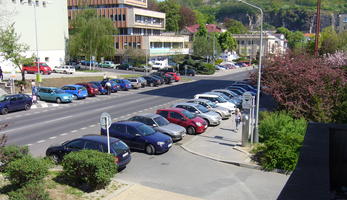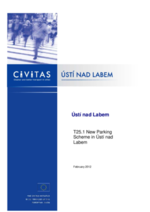Short Term Parking Scheme
Thematic areas
Demand & urban space management
Summary
The city of Usti nad Labem is facing critical parking conditions, primarily in the city centre and in densely build-up residential areas. The city has a target to enhance and expand its parking system by introducing differentiated parking charges in specific city zones. The measure consists of two tasks – a parking strategy study and a short-term parking scheme.
Implementing sustainable mobility
Many urban areas are becoming more and more congested with vehicles as the demand for travel grows in cities. An increased number of vehicles can lead to an unpleasant environment for people in the area. In order to maintain the overall physical planning and develop urban space not only for motorised transport, a parking strategy is needed. The new parking strategy is aimed at planning the short-term parking in the city centre and in residential areas and establishing parking charges, including a parking permit scheme. At first, a feasibility study for a short-term parking scheme was carried out, followed by the implementation scheme.
The measure focused on improving conditions for parking in residential areas and in the city centre with regard to the future motor development. The study benefits from the experience of the leading Archimedes cities as well as other European cities. The proposal for implementing differentiated parking charges aims at reducing environmental impact of individual transport in the area. A survey of the existing parking conditions was conducted for the city centre and for the sample residential area. As a result, traffic problems and lack of space were revealed. Appropriate solutions were proposed. The problems were generalised to serve other localities as well.
Progress
The measure was divided into two specific parts.
The first part was dealing with parking issues in residential areas with dense development, where the amount of vehicles cannot be reduced and there is no capacity to implement additional parking premises. A typical residential area (Dobětice) was examined and conclusions were generalised to serve other localities in the city. In this sample area, the current parking capacity covers about half of the parking demand. Drivers leave their cars at all locations, regardless the traffic laws (within intersections, on both sides of narrow streets, etc.). Passage for other vehicles is difficult and the road safety level is threatened. These conditions are dangerous especially for pedestrians. The deficit can be balanced only by implementing collective public garages with paid services, although, the residents may not be willing to pay for such secure local parking. For the future, the collective garages, zones of paid parking or additional parking places in long walking distances would have to be implemented.
The second part of the measure was dealing with the critical parking conditions in the city centre. This densely build-up area is overwhelmed with vehicles parking everywhere in the streets. Deep analysis of the existing state was conducted and possible solution were designed, involving implementation of paid parking zones and establishing a system of high-capacity parking garages on the perimeter of the city centre (the P&G scheme).
The solution to the parking scheme in the city centre requires that the following conditions be met: • High-quality public transport • Awareness of the population • Increasing parking capacity (building new collective parking garages)
Only after that will it be possible to introduce paid parking zones. The measures implemented in the centre must be accompanied with measures in its close neighbourhoods to prevent shifting of vehicles to these neighbourhoods. It is also necessary to allow activities of citizens in the centre that require travelling by car, so it is not possible to ban vehicles from the centre completely.
However, to improve its parking scheme, Ústí nad Labem must invest an essential amount of money to increase the number of parking places by implementing P&G facilities. Unfortunately, without investing in such facilities, the situation cannot improve; nor can the city consider the efficiency of the measures in the near future.
Beside the specific proposal for the parking scheme suitable for Ústí nad Labem, the measure involved two practical outputs. Firstly, information leaflets have been prepared and published to explain the current system of paid parking in the city centre. They provide basic information on the method of payment and rates and they contain a lucid map displaying the parking facilities. The leaflet is being distributed to the public and is beneficial for visitors, commuters and local people.
Secondly, sample places for delivery vehicles have been established. These places are identified by vertical and horizontal markings and are designated only for vehicles supplying local shops. Shopkeepers have been instructed on the regulations and they should convey the information to their suppliers. To support this measure, parking discs are being distributed among suppliers.
Outcomes
The new parking scheme proposed for Usti nad Labem is aimed at improving road safety, reducing environmental impact of the excessive amount of vehicles operating in the city, increasing aesthetic level of the city centre, improving living conditions for residents and creating better opportunities for pedestrians and cyclists in the city.
Parking in the residential area Dobětice is currently problematic. According to the field surveys, the total number of legal parking places is 1,649, which covers 76 percent of the parking demand and leaves a significant lack of parking spots. The total number of parking places available after implementing measures for parking improvements will be 2,362, which covers the demand for parking by 108.9 percent. Therefore, the overall improvement of the parking status will be 32.9 percent. According to the prognosis from the Roads and Highways Directorate of the Czech Republic from the year 2006, the growth of the motor transport is approximately 2 percent per year, which would exhaust the parking reserve within four years. Due to the ongoing crisis and due to cancellation of the fee for ecological disposal of a wreck, the parking reserve will be exhausted later – in approximately 7-9 years. The more complex long-term solution requires significant investments and consequently the need for charged parking on public roads. The parking situation in the city centre was analysed by the field survey, which revealed, that occupancy as parking demand for parking places cannot be reliably determined. Practically all parking places are permanently occupied, many vehicles park illegally, and therefore it can be assumed, that there are numerous drivers who are not able to park their vehicle at all. Parking demand was thus derived from the methodology based on the Czech standard (ČSN 736110 – Designing local roads) and on general technical requirements for construction in the capital city of Prague. The required number of parking places in the city centre was calculated to determine the overall parking deficit. In accordance with the proposed solutions for the new parking scheme (implementation of paid parking zones and establishing P&G premises on the perimeter of the city centre), after-data are calculated through the traffic model of Usti nad Labem.
The parking scheme issue is quite extensive and the solution is not easy. There are numerous existing parking methods in other locations but only few are suitable for the situation in Usti nad Labem. The process of determining the parking strategy for the city means looking for optimum instruments via compromises between the parking scheme, traffic, public transport and public opinion. It also involves devising a technical solution and conveying information to the public including organising a massive advertising information campaign. Even the best system will not work efficiently without good promotion and thus it would not be as beneficial as the city expected. The city must also cooperate with the Police of the Czech Republic and the Municipal Police. Inspections and penalties can eliminate parking of vehicles in illegal places. Vehicles parked in such places impede vision, posing a risk to traffic safety and hinder the flow of traffic. It is not possible to cover the present and future parking demand entirely, but the parking deficit can be at least minimised.








